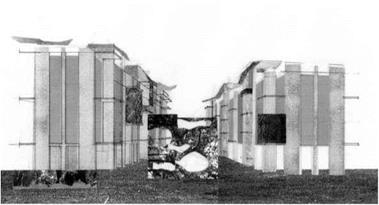Economic return from ground-use can be measured in two ways: one way is to measure direct economic benefits resulting from new employment and enterprises; and the other, arguably more important in the long term, is to measure reductions in environmental degradation, due to productive urban landscapes. These benefits, accruing from reduced environmental impact, lessen the future costs associated with remedial environmental work.
We use the term ‘site yield’ to refer to quantifiable environmental benefits resulting from sustainable development, which utilises, for example, renewable energy systems, rainwater harvesting or includes urban agriculture. Site yield records the proportion of energy, and food requirements that can be harvested from within the boundary of a particular site. In order to get an idea of site yield for developments built to high standards of energy efficiency, we have annualised our design proposals for actual sites in England (Sheffield,
Newark and Shoreditch).The density of occupation for these three sites varies between 92 and 450 persons per hectare. Figure 25.4 indicates the arrangement of buildings and open space on particular sites: Newark consists exclusively of dwellings; Sheffield can accommodate living and working; and Shoreditch provides accommodation for dwellings and social functions, such as libraries, sports faculties and schools. Figures 25.5, 25.6 and 25.7 show that fruit and vegetable production, within the boundary of a site, can be expected to account for about a quarter of annual requirements for densities at or below circa 200 persons per hectare. With densities as high as 450 persons per hectares, if only horizontal surfaces are used for food growing, then fruit and vegetable yield drops to about 10 per cent. By introducing a system of vertical landscaping to high density schemes, fruit and vegetable yields may be increased to circa 30 per cent of annual requirements. In all cases, the proposals are for buildings designed to high standards of energy efficiency, and insulated to levels which effectively eliminate the need for space heating in the English climate (Viljoen, 1997 and Viljoen & Bohn, 2000). Accommodation maximises benefits from natural ventilation and daylight. Buildings use roof space for accommodating solar hot water panels, for the supply of domestic hot water for washing, and photovoltaic panels for the generation of electricity to offset annual domestic requirements. Results from these studies show the significant contribution solar systems can make to energy requirements. The results also suggest that density will limit the potential for developments utilising solar power for all energy requirements when it approaches 450 persons per hectare.
The potential for collecting rainwater from roofs, for domestic consumption, is modest for all three examples. Organic urban agriculture has an indirect
Figure 25.2 Victoria Park CPUL: Apartment plans showing private ‘house garden’ balconies, workshop and office space adjacent to public and productive landscape.
|
benefit with respect to reducing water consumption. Enriching soil with composted organic matter improves its water retaining potential, thereby requiring less water for irrigation.
Figures 25.5, 25.6 and 25.7 represent ecological yields derived from particular sites, integrating a number of environmental features in a coherent overall design strategy. Significant additional contributions to the percentage of locally produced food would result from the development of peri-urban agriculture.
Instigating a bounding ring, or wide network of market gardens adjacent to densely built urban centres, provides further opportunity to reduce dependence upon remotely produced food. Considering that allotments were providing 50 per cent of Britain’s fruit and vegetable requirements during the Second World War (Crouch and Ward, 1988), it is not impossible to imagine a large city like
London aiming for self-sufficiency in fruit and vegetable production from CPULs and peri-urban agriculture.
Further indirect economic advantages will be derived from health and social benefits (see Chapter 3).




